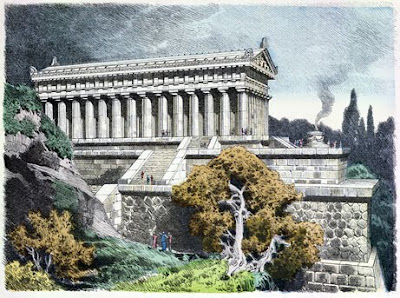 The Statue of Zeus at Olympia, Greece
The Statue of Zeus at Olympia, GreeceParanormal activities,Strange Things and people,Ghost Pics,Haunted House,Haunted Place,Yeti,Big Foot.
Ancient seven WONDER of the WORLD(The Statue of Zeus at Olympia, Greece)
 The Statue of Zeus at Olympia, Greece
The Statue of Zeus at Olympia, GreeceAncient seven WONDER of the WORLD(The Temple of Artemis, Turkey)
 The Temple of Artemis, Turkey
The Temple of Artemis, TurkeyAncient seven wonder of the world(The Mausoleum of Halicarnassus, Turkey)
 The Mausoleum of Halicarnassus, Turkey
The Mausoleum of Halicarnassus, TurkeyThe famous tomb at Halicarnassus—now the city of Bodrum—was built between 370 and 350 B.C. for King Mausolus of Caria, a region in the southwest of modern Turkey. Legend says that the king's grieving wife Artemisia II had the tomb constructed as a memorial to their love.
Mausolus was a satrap, or governor, in the Persian Empire, and his fabled tomb is the source of the word "mausoleum." The structure measured 120 feet (40 meters) long and 140 feet (45 meters) tall.
The tomb was most admired for its architectural beauty and splendor. The central burial chamber was decorated in gold, while the exterior was adorned with ornate stone friezes and sculptures created by four Greek artists.
The mausoleum stood intact until the early 15th century, when Christian Crusaders dismantled it for building material for a new castle. Some of the sculptures and frieze sections survived and can be seen today at the British Museum in London, England.
Ancient seven wonder of the world(The Lighthouse of Alexandra, Egypt)
 The Lighthouse of Alexandra, Egypt
The Lighthouse of Alexandra, EgyptThe lighthouse was the only ancient wonder that had a practical use, serving as a beacon for ships in the dangerous waters off the Egyptian port city of Alexandria, now called El Iskandarîya.
Constructed on the small island of Pharos between 285 and 247 B.C., the building was the world's tallest for many centuries. Its estimated height was 384 feet (117 meters)—equivalent to a modern 40-story building—though some people believe it was significantly taller.
The lighthouse was operated using fire at night and polished bronze mirrors that reflected the sun during the day. It's said the light could be seen for more than 35 miles (50 kilometers) out to sea.
The huge structure towered over the Mediterranean coast for more than 1,500 years before being seriously damaged by earthquakes in A.D. 1303 and 1323.
Ancient seven WONDER of the WORLD(The Hanging Gardens)
 The Hanging Gardens of Babylon, Iraq
The Hanging Gardens of Babylon, IraqThe hanging gardens are said to have stood on the banks of the Euphrates River in modern-day Iraq, although there's some doubt as to whether they ever really existed.
The Babylonian king Nebuchadnezzar II supposedly created the terraced gardens around 600 B.C. at his royal palace in the Mesopotamian desert. It is said the gardens were made to please the king's wife, who missed the lush greenery of her homeland in the Medes, in what is now northern Iran.
Archaeologists have yet to agree on the likely site of the hanging gardens, but findings in the region that could be its remains include the foundations of a palace and a nearby vaulted building with an irrigation well.
The most detailed descriptions of the gardens come from Greek historians. There is no mention of them in ancient Babylonian records.
$1m (£609,000) reward to anyone who can prove the existence of a mermaid in its waters

Israel is in the grips of mermaid fever after numerous sightings of the mythical sea creature off its coast.One town council is taking the reports so seriously it is offering a $1m
(£609,000) reward to anyone who can prove the existence of a mermaid in its waters.
Kiryat Yam municipality, near Haifa, says it has been told of dozens of sightings in the past few months.
Council spokesman Natti ZilbermanThey say it is a female figure, it looks like a young girl.

"Many people are telling us they are sure they've seen a mermaid and they are all independent of each other," council spokesman Natti Zilberman told Sky News.
The nautical nymph is only seen in the evening at sunset, according to media reports, drawing crowds of people with cameras hoping for a glimpse.
"People say it is half girl, half fish, jumping like a dolphin. It does all kinds of tricks then disappears," Mr Zilberman said.
Asked whether a dolphin or large fish could be a more rational explanation, he insisted: "They say it is a female figure, it looks like a young girl."
The council denied its offer of a reward was a publicity stunt, but said it hoped to nurture the mermaid as something which could bring in more tourists.
Capturing a mermaid is not necessary, a verifiable photograph will do, Mr Zilberman said.
Asked if the council can afford the payout, he told Sky News: "I believe, if there really is a mermaid, then so many people and tourists will come to Kiryat Yam, a lot more money will be made than a $1m.
